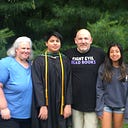Confronting, Not Just Condemning, Violent Far-Right Extremism
We often credit the TV series The West Wing with being a harbinger of politics in the United States, with the later seasons foreseeing the optimism and potential of the Obama Administration. Looking closer, though, we can find that the series also saw one of the darkest sides of political activism, foreseeing the threats of violent right-wing extremism in the United States.
How? It begins Season One, a white supremacist organization targets the President’s daughter for dating a Black aide, continues through the assassination attempt against the President in the two-part In The Shadow of Two Gunmen episodes, and even continues through Season Four with a pipe bombing on a college campus that killed several students. As far back as 1999, Aaron Sorkin and his politicos turned TV team realized that hate-driven violence was a clear and present danger to the United States of America.
This was about far more than taking artistic license with the Oklahoma City bombing of 1995. No, this was about realizing that the greatest threat to American democracy is from within. It is about realizing that the diversity of backgrounds, opinions, and actions that truly make America great is what most threatens to tear us apart. It is about knowing that hate and divisiveness, left unchecked and unaddressed, is what places our republic at greatest risk.
While we may clutch our collective pearls upon seeing that Nick Fuentes met with the former President of the United States, the threat of actual violent far-right extremism is far greater. Earlier this year, the Center for Strategic & International Studies reported that the percentage of domestic terrorist activity jumped from 2 percent of incidents in 2019 to 47 percent in 2020. That doesn’t even begin to account for recent events such as Colorado Springs, Buffalo, or even January 6. We breathe easier when an 18-year old who threatened synagogues in New Jersey is arrested by the FBI before following through, without considering the countless threats are only learned of after the fact, discovered on online platforms such as Discord, 4Chan, and those in between.
Yes, violent far-right extremism is a real and constant threat, one that we have feared and spotlighted in popular media for decades. But these are not threats and realities that are the product of AI. These are all actions that are planned by those who have felt isolated, disconnected, and unwelcomed by our civil society. They were executed by those who blamed others for taking from them what they thought they were entitled to. They were celebrated by those who hate and fear those who look different from them. And they must be addressed at that human level.
At a recent forum on extremism at the Cinema Arts Centre in New York, I spoke of how hate and extremism in this nation has grown exponentially in recent years. A few decades ago, far-right extremism was largely ant-Black hate. Today, there is a flavor of hate for just about anyone. Anti-Black. Anti-Jewish. Anti-immigrant. Anti-undocumented immigrant. Anti-woman. Anti-Muslim. Anti-LBTQIA. Anti-government. And the list grows each day.
With all that anti-humanity, pro-hate belief, it is no wonder that I’m often asked if such extremists, such haters, are worth our time or attention, much less redemption. After all, how can we show empathy and compassion to those who have thought so little of our friends, our communities, and our society?
I’d counter, how can we not?
The rapid growth in domestic terrorism and expressions of violent far-right extremism (VFRE) can be linked to the embraced divisions in our communities. So many of those who embrace a life of VFRE initially do so not because they subscribe to the ideology, but because they are seeking a sense of belonging, a sense of family, at a time when they feel isolated and alone. Those who recruit from extremist groups know this. They prey on it. They exploit it. They require it. Soon, individuals embrace and parrot the ideology to hold onto their sense of belonging, thinking that civil society will never welcome them back after the horrible words they have said and deeds they have performed.
Yes, it can be incredibly difficult to understand how one can spew hate, embrace intolerance, and commit acts of violence again those we love. It is even harder to show those individuals understanding and compassion. But if we aren’t willing to do so, there is no way we can deradicalize extremists and disengage them from hate groups. If we aren’t willing to do so, we only encourage them to get deeper and deeper into hate movements, forcing them to believe there is path back.
Those that have lived a life of hate must take accountability for their past beliefs and past actions. They must take responsibility for who they were and who they hurt. In return, we must show compassion and empathy to those looking to mend their lives and their souls.
None of us wish to be judged by the worst, darkest moments of our lives. We all, to a degree, seek some level of redemption. And we all must learn to show such grace and offer such understanding to allow the darker corners of our society to begin to receive some sunshine.
While TV dramas can simply move onto the next season, shifting to a new enemy and a new threat to hold viewer attention, we cannot. For decades, we’ve know that violent far-right extremism has been a threat to our nation and our people, dating back to the Ku Klux Klan and the late 1800s. After decades of condemnation and outrage, the dangers only seem to grow more and more significant. Perhaps it is time to begin to solve the problem, offering ways for individuals to leave hate movements and prove they can be productive members of our society.
As recent years have shown, the costs to our community are simply too expensive for us to not try.
